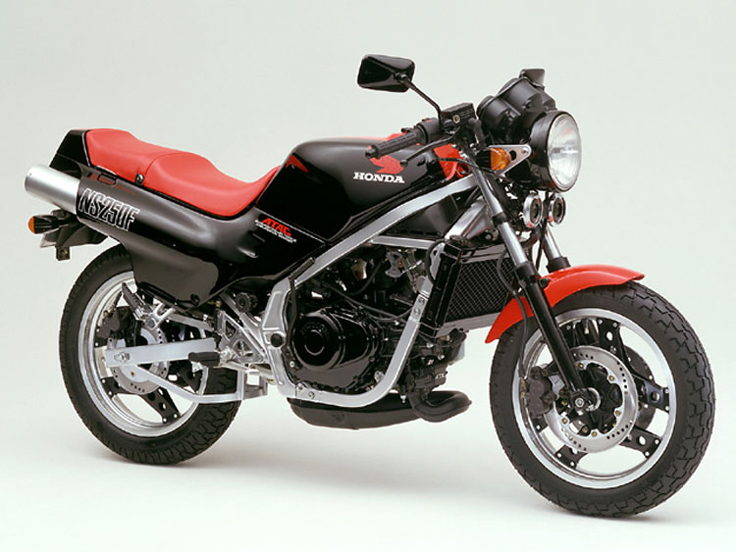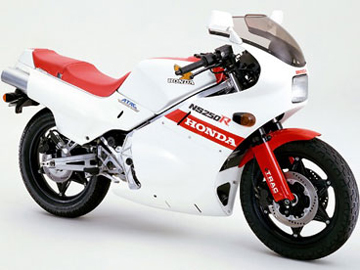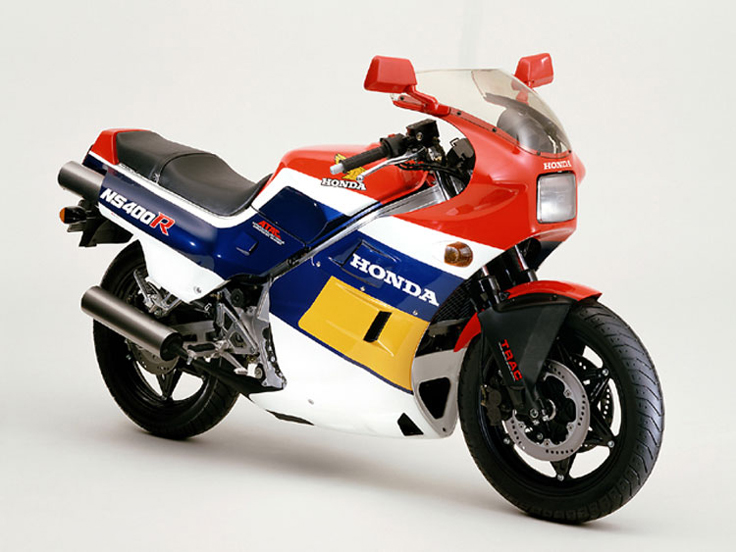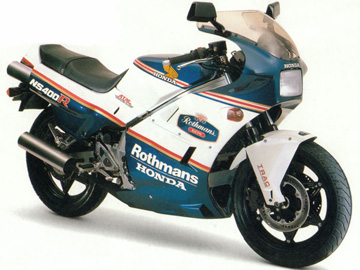Price: Y539,000(R) Y429,000(F)

On May 25th 1984, Honda motor company introduced two new high-performance sport bikes. The Honda NS250F and the Honda NS250R are filled with bold style and a newly designed liquid-cooled 2-stroke 90 Degree V-twin engine (displacement is 249cm3). Light weight cylinders are coated with new seizure and abrasion resistance material and the exhaust system is automatically controlled with a state-of-the-art electronic adjusting torque amplification technology.
The NS250F/R was developed using the latest sophisticated technologies gained from the 1983 MotoGP world Champion racer "Honda NS500". The NS250F uses a steel frame while the NS250R is equipped with an aluminum frame and a full fairing.
The engine is a lightweight, slim and compact designed V-twin 90 degree angle to help reduce vibration. The inner walls of the cylinders uses the NS cylinder coating technology which is nickel silicon carbide particles dispersed in the cylinder body wall surface. Using this technology and light weight aluminum pistons, wear resistance and seizures are reduced.
Auto-Controlled Torque Amplification Chamber (ATAC) exhaust system is used which changes the exhaust capacity automatically by checking the engine RPM electrically to obtain the best effective power delivery. Using this, High output and high RPM's are capable (maximum power output 45 PS/9,500 RPM and maximum torque of 3.6 kg-m/8,500 RPM).
Computer analysis is used to produce the light weight, high rigidity double cradle, angled square cross section chassis (F type if steel, R type if aluminum). The Front suspension uses air-assisted load-adjustable telescopic forks and the rear uses multi-weight adjustable Pro-Link suspension. Honda included the TRAC (Torque Reaction Anti-Dive Control) system to the front suspension to reduce the chassis position during braking and provide superior road handling capabilities. Dual front disc brakes are included with two piston brake calipers and a single semi-metal single piston caliper on the rear wheel. The F model has a 16 inch front wheel and a 17 inch rear wheel both are all aluminum. The R model adopts the NS Comstar wheels front and rear. In addition to handle the high-performance load, the R model is fitted with a sport style full fairing.
The 250cc class had a total of 9 models and 14 different types of options, providing a response to a much broader group of customers.

| SPECIFICATION 1984 NS250F/R | ||
| NS250F | NS250R | |
| Model | MC11 | |
| Lenght | 249m | |
| Width | 56.06m | |
| Height | 1.040m | 1.125m |
| Wheel Base | 1.375m | |
| Ground Clearance | 0.145m | 0.135m |
| Seat Height | 0.780m | |
| Weight (Dry) | 161 (144)kg | |
| Seating Capacity | 2 persons | |
| Fuel Economy | 41.0km/l (at 50km/h) | |
| Engine Type | MC11E | |
| two-cycle - liquid-cooled | ||
| 90 degree V-twin | ||
| Displacement | 249cm3 | |
| Bore X Stroke | 56.0 X 50.6 mm | |
| Compression Ratio | 7.0 | |
| Maximum Output | 45PS/9,500rpm | |
| Maximum Torque | 3.6kg-m/8,500rpm | |
| Starting Method | Kick | |
| Ignition | CDI | |
| Oil Capacity | 1.7l | |
| Fuel Capacity | 19l | |
| Transmission | Constant Mesh 6-speed | |
| Tire Size (Front) | 100/90-16 54 S | |
| Tire Size (Rear) | 110/90-17 60 S | |
| Brakes (Front) | Hydraulic Dual Disc | |
| Brake (Rear) | Hydraulic Disc | |
| Suspension (Front) | Telescopic (Air-assisted suspension) | |
| Suspension (Rear) | Swing Arm (Pro-Link) | |
| Frame | Double Cradle | |
Price: Y629,000


| SPECIFICATION 1985 NS400R | ||
| Model | NC19 | |
| Lenght | 2.025m | |
| Width | 0.720m | |
| Height | 1.125m | |
| Wheel Base | 1.385m | |
| Ground Clearance | 0.135m | |
| Seat Height | 0.780m | |
| Weight (Dry) | 183 (163)kg | |
| Seating Capacity | 2 persons | |
| Fuel Economy | 29.0km/l (at 60km/h) | |
| Engine Type | NC19E | |
| two-cycle - liquid cooled | ||
| 90 degree V-3 cylinder reed valve | ||
| Displacement | 387cm3 | |
| Bore X Stroke | 57.0 X 50.6 mm | |
| Compression Ratio | 6.7 | |
| Maximum Output | 59PS/8,500rpm | |
| Maximum Torque | 5.1kg-m/8,000rpm | |
| Starting Method | Kick | |
| Ignition | CDI | |
| Oil Capacity | 2l | |
| Fuel Capacity | 19l | |
| Transmission | Constant Mesh 6-speed | |
| Tire Size (Front) | 100/90-16 54 H | |
| Tire Size (Rear) | 110/90-17 60 H | |
| Brakes (Front) | Hydraulic Dual Disc | |
| Brake (Rear) | Hydraulic Disc | |
| Suspension (Front) | Telescopic (with air spring cylinder) | |
| Suspension (Rear) | Swing Arm (Pro-Link) | |
| Frame | Double Cradle | |
The NS400R was originally developed and introduced a number of the latest technologies that came out of the "Honda NS500" which was competitive and won the world race 500GP champion for two consecutive year (1983 and 1984).
The NS400R has a Honda V 3-cylinder engine with a 90-degree crankcase with 2-cylinder front and 1 cylinder rear, lightweight slim and compact design. By adopting the NS cylinders coated with a special treatment of carbide, nickle and silicon cylinder walls, helped improve durability and reduce friction. The ATAC (Auto-Controlled Torque Amplification Chamber) exhaust system uses high speed needle bearings on stainless steel connecting rods that are designed to electronically detect the engine speed and automatically adjust the volumn of the exhaust chamber allowing for greater power and a smoother torque curve. Through these technologies, you have a high torque at low and medium speed ranges, that provides a high perfromance engine that runs smoothly at high speeds (59PS/8500rpm maximum power with maximum torque of 5.1kg-m/8000rpm).
The double cradle frame uses a rectangular cross-section tubing and clear anodized coated surface, in addition the body and the frame are computer designed for lightweight and high rigidity. The front wheel suspension is air-assisted for varying loads, and the Pro-Link rear suspension is equipped for multi-stage adjustable weights. The compact braking system is coupled with the TRAC (Torque Reaction Anti-Dive Control) to help reduce the front of the motorcycle from squatting and provide superior handling characteristics for all road condition. It's equipped with dual front disc brakes with dual piston calipers and single disc semi-metalic pads. By using a 16-inch front and 17-inch rear Honda's own Comstock all-aluminum wheels, greatly reduces unsprung weight and provides high rigidity. In addition to all this being standard equipment to handle the additional load from a sportbike, an aerodynamically designed full fairing is also included as standard equipment.
Honda has also adopted two body color schemes, the Honda Racing Tricolor scheme (Red, White and Blue) and shares the colors from this years Honda (HRC) Sponsor, British Tobacco manufacturer Rothmans (a combination of blue and white).